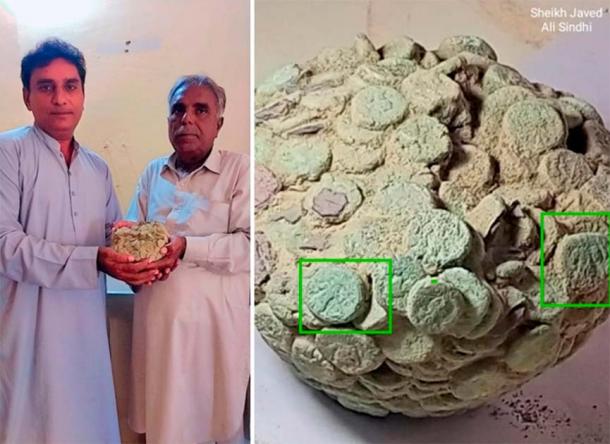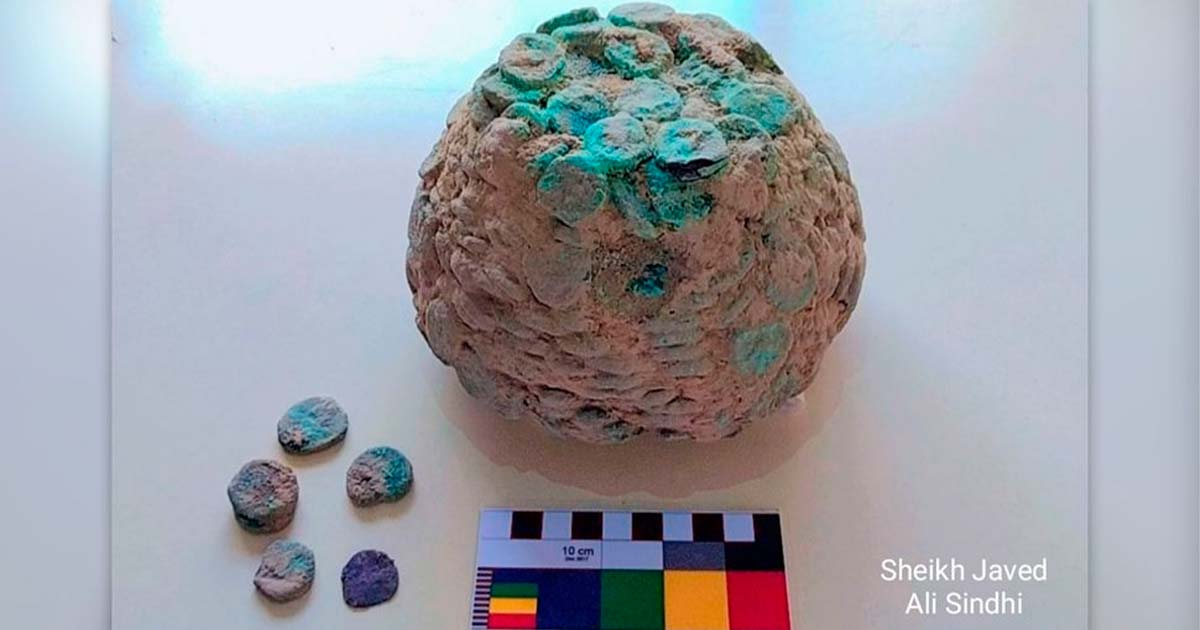2,000-Year-Old Coin Hoard Unearthed at Buddhist Stupa at Mohenjo-Daro!
A recent archaeological discovery in Pakistan has unveiled an unbelievable hoard of copper coins, believed to be over 2,000 years old, within the ruins of a Buddhist stupa (shrine) at the ancient site of Mohenjo-Daro! This site, dating back to around 2600 BC, is part of the ancient Indus Valley/Harappan civilization, regarded as one of the oldest civilizations globally.
The coins and the stupa are attributed to the time of the Kushan Empire, a predominantly Buddhist realm that ruled from the second century BC to the third century AD after conquering the Greco-Bactrian Kingdom established in Central Asia by Alexander the Great.
"The stupa was built on the top of deserted ruins of Mohenjo-Daro after its decline [around] 1,600 years later," archaeologist and guide Sheikh Javed Ali Sindhi told Live Science.

At the location of the coin hoard find in Mohenjo-Daro. (Sheikh Javed Ali Sindhi)
On the Deserted Ruins of Mohenjo-Daro: The Kushan Stupa
The unearthed coins exhibit a greenish hue due to copper corrosion. They were discovered during a salvage excavation prompted by a wall collapse at the site. The fused hoard, weighing approximately 12 pounds, likely comprises between 1,000 and 1,500 individual coins. Some coins within the hoard depict a standing figure believed to represent a Kushan king.
The findings are particularly significant as they mark the first artifacts discovered at the stupa's ruins since 1931. The coins bear resemblance to earlier discoveries from the 1920s and 1930s, featuring depictions of a standing figure and, on the reverse side, representations of Hindu god Shiva and other symbols, reflecting the syncretism of Buddhist beliefs with Hindu origins.
- Discovery of Three Chariots in India Suggests Warrior Class of Ancient Civilization
- Mohenjo Daro and The Mounds That Hid a Civilization

Sheikh Javed Ali Sindhi and another archaeologist with the hoard of coins. Right, close up of the coins. (Sheikh Javed Ali Sindhi)
Mohenjo-Daro and the Influence of Buddhism
Mohenjo-Daro was once a thriving city of the Harappan civilization, abandoned around 1800 BC, possibly due to climate change leading to a drying environment. The Buddhist stupa at the site was constructed around 150 AD, during the Kushan Empire's rule, but was eventually abandoned by 500 AD, potentially due to earthquakes or a decline in Buddhist influence.
The Kushan Empire, by that time, had fragmented into independent kingdoms, facing successive conquests by the Sasanian Persians and northern invaders, possibly associated with the Huns, reports Harappa.com.
- Extraordinary Buddhist Sculptures Unearthed in the Ruins of an Ancient City in Pakistan
- The Indus Valley Civilization: An ornamented past, revealed in 5,000-year-old artifacts
Buddhism originated in the 6th century BC in ancient India, in the region that is present-day northeastern India and parts of Nepal. Siddhartha Gautama, later known as the Buddha, founded the religion based on his insights into the nature of suffering and the path to enlightenment.
Ancient Buddhism found fertile ground for growth and development in the region that is now Pakistan. Emperor Ashoka's patronage in the 3rd century BC significantly influenced the spread of Buddhism, with missionaries dispatched to various parts of the Mauryan Empire, including present-day Pakistan. Evidence of this was also unearthed last year when a unique Buddha pendant was unearthed in Mohenjo-Daro, evidence of this shared history.
The Gandhara region, encompassing parts of modern Pakistan and Afghanistan, emerged as a prominent center for Buddhist art and culture during the Kushan Empire's rule in the 1st to 3rd centuries AD. Taxila, an ancient city in Pakistan, became a vital hub of Buddhist learning, housing one of the world's oldest universities and serving as a repository for Buddhist stupas and monasteries. The Silk Road further facilitated the exchange of Buddhist ideas and artifacts.
However, with the decline of the Kushan Empire and the advent of Islam in the 7th century, Buddhism gradually waned in influence. Many Buddhist monasteries and sites fell into disuse or were repurposed. Notwithstanding this decline, surviving sites such as Taxila continue to bear witness to the rich Buddhist heritage that once thrived in the region.
Top image: The coins found at he coins date from the period of the Kushan Empire, which ruled the region from about the second century BC until about the third century AD Source: Sheikh Javed Ali Sindhi
By Sahir Pandey
References
Metcalfe, T. 2023. 2,000-year-old coin stash discovered at ancient Buddhist shrine in Pakistan. Available at: https://www.livescience.com/archaeology/2000-year-old-coin-stash-discovered-at-ancient-buddhist-shrine-in-pakistan.

















